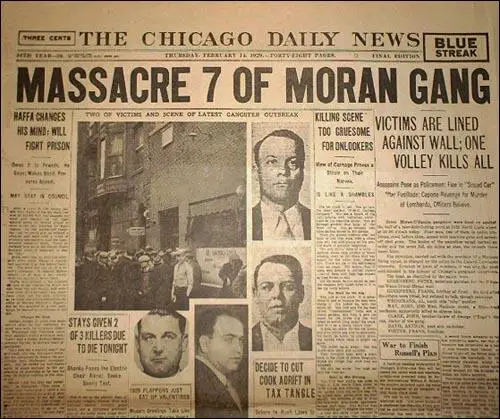St Valentine's Day Massacre
Dion O'Banion was the owner of a florist shop in Chicago. After the passing of the National Prohibition Act he was also one of the main providers of illegal alcohol in Chicago. In 1926 O'Banion was shot dead outside his shop. His gang were convinced that the murder had been ordered by Al Capone, a rival bootlegger. Soon after O'Banion's death eight cars filled with gangsters, raked Capone's headquarters with machine-gun fire. This heralded the start of Chicago's gar wars. Over the next few years over 500 gangsters were killed in the city. The most notorious case was an event that became known as the St. Valentine's Day Massacre.
At half-past ten on 14th February, 1929, six members of the Bugs Moran gang were sitting in a garage waiting for a consignment of illegal alcohol. Instead a Cadillac arrived carrying three men dressed as policemen. They were accompanied by two men in civilian clothes. The policemen entered the building and told the six gangsters and John May, a mechanic working in the garage, to stand in a row against the wall with their hands in the air. This was common procedure during a police raid and the men did as they were told. Two civilians then entered the garage and mowed them down with sub-machine gun fire.
Walter Trohan was the first reporter to arrive at the garage: "I was the first man on the scene of carnage, being careful to avoid the hinging of the crazed police dog chained to one of the garage trucks. The most memorable remark of the day was that of O'Rourke of the Chicago Evening American who looked down at his feet after tracking around the garage and said: 'I've got more brains on my feet than I have in my head.' Other staffers joined me in tracing the path of ambush and the story of the slaying of six members of the George (Bugs) Moran mob, rivals of the Al Capone gang."
John Miller of the Chicago American arrived soon afterwards: "Sprawled grotesquely at the base of the bullet-riddled stone wall were six distorted bodies; a seventh lay slumped over a wooden chair. One of the officers called out, 'This one's Pete Gusenberg, an ex-con and the chief gunner for the Drucci-Moran gang. Here's Al Weinshank, the North Side booze runner, and Artie Davis from the West Side mob. And this was James Clark, Bugs Moran's brother-in-law. Here what's left of Doc Schwimmer.' The other mobster was Frank Gusenberg, the only one still alive. He died within half an hour without giving the police any information. Although it was assumed that the murders had been ordered by Al Capone, no one was ever convicted of the crime.

Primary Sources
(1) John Miller, photographer with the Chicago American (February, 1929)
I was on assignment at Van Buren and Ogden Avenue, and had just called the office. They told me to go to Garfield and North Clark where there was a shooting. I got into my car, raced through red lights, and got there just as the first bunch of cops were going in. I went with them.
Sprawled grotesquely at the base of the bullet-riddled stone wall were six distorted bodies; a seventh lay slumped over a wooden chair. One of the officers called out, "This one's Pete Gusenberg, an ex-con and the chief gunner for the Drucci-Moran gang. Here's Al Weinshank, the North Side booze runner, and Artie Davis from the West Side mob. And this was James Clark, Bugs Moran's brother-in-law. Here what's left of Doc Schwimmer." The other mobster was Frank Gusenberg, the only one still alive. He died within half an hour without giving the police any information.
(2) Walter Trohan, Political Animals: Memoirs of a Sentimental Cynic (1975)
I was the first man on the scene of carnage, being careful to avoid the hinging of the crazed police dog chained to one of the garage trucks. The most memorable remark of the day was that of
O'Rourke of the Chicago Evening American who looked down at his feet after tracking around the garage and said: "I've got more brains on my feet than I have in my head." Other staffers joined me in tracing the path of ambush and the story of the slaying of six members of the George (Bugs) Moran mob, rivals of the Al Capone gang.

